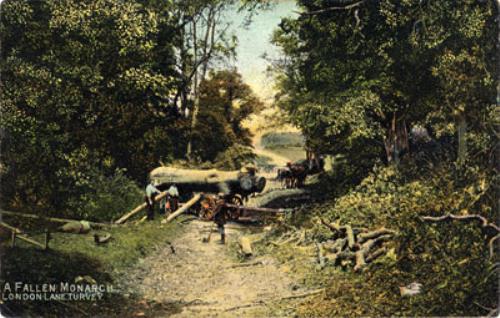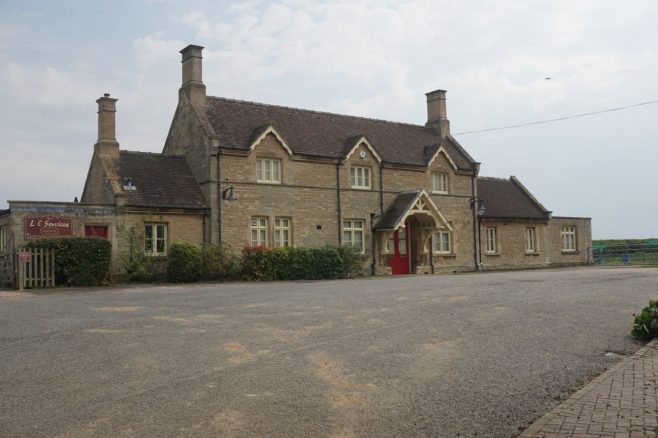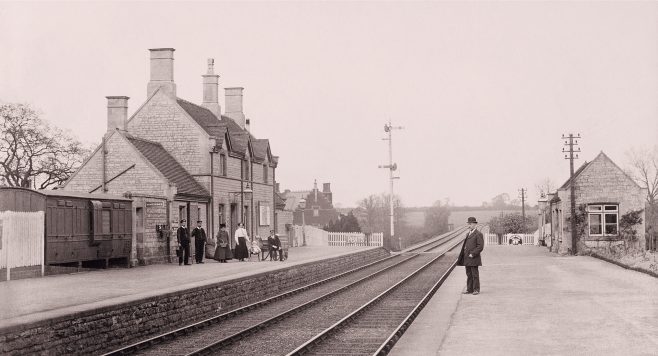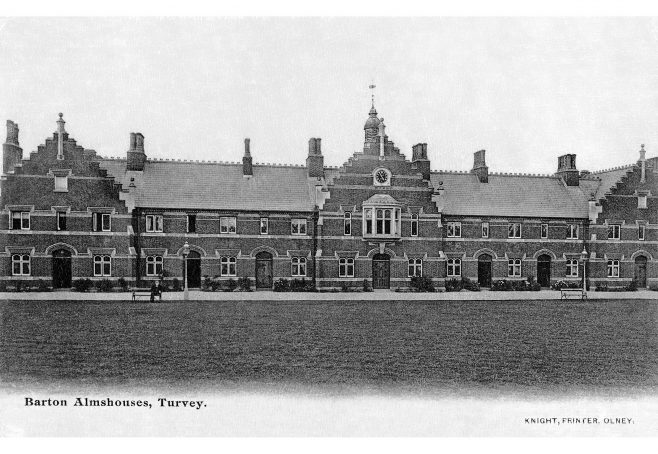Priory Farm
It is hard to imagine, given the open landscape between Turvey Abbey and Station End that this route of one mile was once covered in trees. We first come to Priory Farm, which was once part of the Turvey Abbey Estate. The present buildings date from the mid 1800s, but older maps indicate that farm buildings existed here well before that time.
Drovers Road
From the Middle Ages until the coming of the railways, livestock were herded, often over long distances (geese would have their feet covered in tar!) across Britain from rural areas where they had been raised to markets in towns and cities. The byways they travelled, usually avoiding villages and towns, were known as drovers’ roads. Many of he routes led to London as was the drovers road in Turvey.
Opposite Priory Farm is a footpath which was once part of a drover’s road called London Lane. As can be seen from the image, this would have been wide enough for a herd of sheep or cattle to pass along and the grass verges on either side provided an opportunity for the animals to graze. London Lane went south and passed an inn and farmhouse on Grindstone Hill, as described by Ralph Leaper, former Farm Manager to the Turvey Farm Estate.
The farm became a dairy and stock farm. At some point this farm ceased to function and the buildings were demolished. It was common for farms and rural inns to provide overnight pasture and accommodation for the drovers.

Redlands Farm and Yard on Grindstone Hill. Watercolour by John Higgins circa 1820. © J. Longuet Higgins
Drovers had to be licensed in Tudor England and were required to be a married householder and at least 30 years old. This reflected their considerable responsibility in not only looking after a farmers herd and safely transporting them to market but also in extracting a fair price and returning the income to the farmer. After market Drovers would return to their starting point by coach whilst their dogs, having learnt the route, would return home using the Drovers’ roads. Licensing of drovers continued until 1772.
Turvey Station
As the name suggests, Station End is where Turvey Station once stood. The first train to stop at the station did so on 10th June 1872 on its way from Bedford to Northampton. It had taken nearly thirty years of campaigning, planning, fund raising and then construction. The railway was built with the help of 200 navvies who were accommodated in huts built by Charles Longuet Higgins in Bakers Close. Colonel William Bartholomew Higgins of Picts Hill House, who was Chairman of the Railway Company, had a working men’s room built on the corner of Bamford’s Yard and the High Street, which provided reading material and light sports for the workers.
The station initially had five trains a day stopping in each direction. This had increased to seven a day by 1938. Special day trips to the Towcester Races were also available. The line was very busy during the Second World War with one track being used to store war materials. After the war the line was used less and less and was eventually closed with the last train calling at Turvey Station on 3rd March 1962.
The railway line went across the Bedford Road by means of a bridge. However, in the early 1960’s it became apparent that the bridge was too low for the growing number of double decker buses and lorries that wished to use the road. Consequently, the road was lowered (hence the present dip in the road) only for the bridge to be demolished shortly after. The railway line was not without its accidents, Ralph Leaper remembers the train derailment on 17th June 1960.
A question often asked is why build a station one mile from the village? Conspiracy theorists suggest that the original intention was to have the station on Carlton Road, but this was resisted as it would cut across the Higgins Estate; alternatively, perhaps, Colonel Higgins wanted the station built near his home. A more prosaic answer could be that the flattest route was chosen in order to manage costs.
The introduction of the railway had a big impact on the village. Journeys to Bedford and Northampton were now much easier as was access to more distant places. The railway also enabled people to visit Turvey and the village became something of a tourist attraction, particularly for people from Northampton, who often came for the fishing. The Railway Swan public house was opened in 1881 (it was converted to residential properties in 1995) and was followed by the building of “villas” for commuters in 1885.
Barton & Royle Homes
The Barton Charity originated in 1881 in order to provide “asylum” for the deserving and poor of Turvey and Bedford. James Barton bought land and provided funds for the Almhouses and Memorial Hall to be built. The building was officially opened on Wednesday 24th June 1885; its purpose to house 10 married couples and 10 single persons, together with accommodation for a caretaker and his wife.
Each resident had a bedroom and living room and shared the use of the washhouse, kitchen and scullery. They were required to follow a set of rules and to attend weekly religious services in the memorial hall, where entertainment was also provided.
By the 1950s, the cost of maintaining and improving the original building was causing the charity significant problems. Sir George Royle, a former Mayor of Bedford, had left provision in his will (1950) for the establishment of almhouses for the people of Bedford. This scheme never took off and, after years of negotiations, the two charities were combined to form the Barton and Royle Homes in 1963. The old building was demolished and replaced by new almshouses, eighteen of which called the Royle Homes with the other eight called Barton Homes. A chapel and communal room were also provided. As the bungalows were built, residents from the old building were gradually rehoused. The demolition and ultimate completion of the new buildings took place in 1966.
We now move on to stop 15, the northern side of the High Street.












No Comments
Add a comment about this page